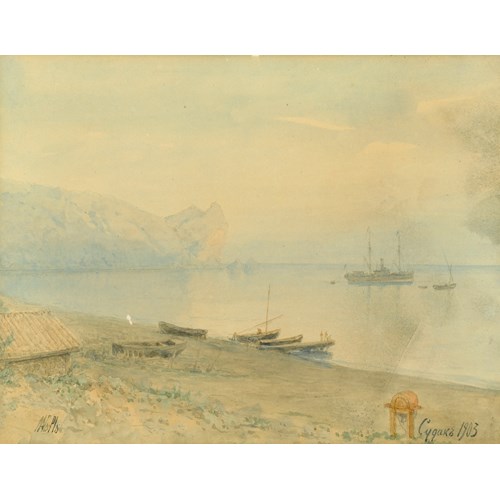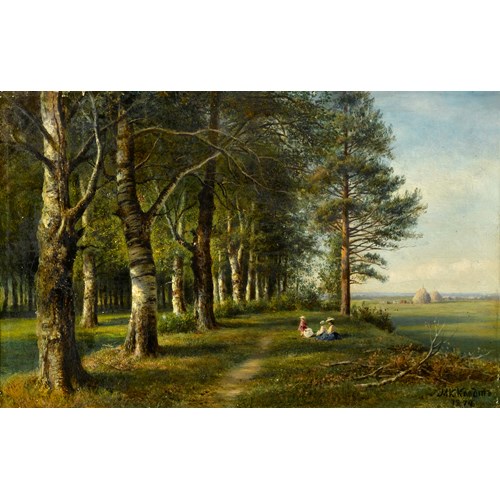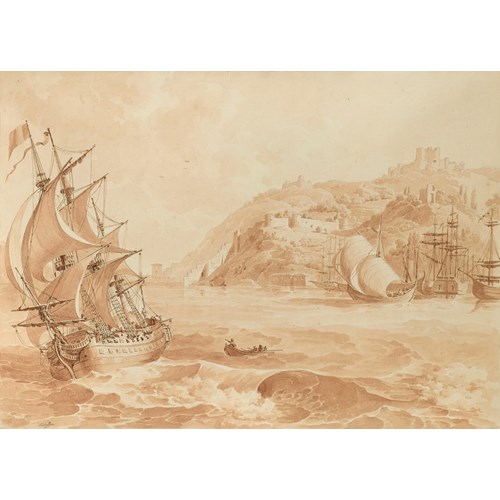Marketplace
The Archangel Michael
Jacopo Vignali
The Archangel Michael
Epoque 1600-1750, 17th century
Origine Italy
Medium Oil on canvas
Dimension 115.1 x 87.6 cm (45³/₈ x 34¹/₂ inches)
Jacopo Vignali’s painting of The Archangel Michael brilliantly evokes the strength and authority of his subject, the field commander of the Army of God, as well as emphasising his beauty and youth. Vignali’s naturalistic style, dramatic use of chiaroscuro and elegance in balancing colour and design is true to the Florentine baroque tradition.
The archangel wears a lustrous blue tunic evoking Roman armour and thus great heroism, with tasselled shoulders and a neckline embroidered in gold. An ornate plumed helmet adorns his head. The costume presents the perfect opportunity for Vignali to showcase his talent in depicting rich materials and a variety of textures and tones. Michael holds two of his attributes, the scales used to judge men’s souls, and the red banner, a reminder of his secondary role, popularised in late medieval imagery, as a knight and slayer of dragons.
The majority of Vignali’s oeuvres were devoted to images of saints designed for ecclesiastical commissions, and the Archangel Michael figures prominently. In the church of S.S. Michele e Gaetano, Florence, a painting by Vignali of the archangel freeing souls from purgatory reveals him in his role as liberator, judging the good from the bad, and leading them before the tribunal of God. Although a complex composition featuring several figures, the representation of Michael is remarkably similar to the present painting. He, like the angels accompanying him, is sensually depicted as a young man with abundantly curly hair, full lips, bright eyes and a pure complexion. He wears a blue tunic embroidered in gold and carries a banner. The interplay of light and shadow is prominent in both paintings and in the version in the church of S.S. Michele e Gaetano is heightened by the thunderous clouds overhead and the fiery furnace from which desperate men are being saved. The present painting offers a more personal and psychological portrayal of Michael, showing him caught in an unsuspecting moment from a close vantage point. As he locks gaze with the viewer, one detects a softer human side to the archangel and in his disarming expression there is a note of vulnerability that contradicts his fearsome power.
Vignali was a precocious artist and at an early age entered the studio of Matteo Rosselli in Florence. In 1616, he was admitted to the Academia del Disegno in Florence and became an academician in 1622. In the 1620s his works developed a new boldness in employing colour, lighting and expression, moving away from the influence of Rosselli. As well as being an easel painter, Vignali also contributed to fresco cycles and ceiling decorations for patrons such as the Medici family. He took inspiration from a variety of fellow Italian artists as his career progressed, including Orazio Gentileschi, Filippo Napoletano, Rutilio Manetti, Guercino, Francesco Curradi and Giovanni Lanfranco. The early 1630s were a particularly productive period for Vignali and in 1632 he painted his first commission for the church of S.S. Michele e Gaetano, painting the ceiling frescoes, two lunettes and a lateral composition for the Bonsi Chapel. In the 1640s, his works took on a greater monumentality, evidenced by works such as Liberation from Souls of Purgatory. Later in the decade, his compositions became increasingly dark and meditative, often depicting scenes of death or martyrdom. Vignali had several pupils, the most successful being Carlo Dolci, who adopted and enhanced the ardent religiosity of his master’s works to great effect.
We are grateful to Professor Mina Gregori, who confirmed the attribution to Vignali at the time of the 2002 sale, and dated the painting to c.1620.
The archangel wears a lustrous blue tunic evoking Roman armour and thus great heroism, with tasselled shoulders and a neckline embroidered in gold. An ornate plumed helmet adorns his head. The costume presents the perfect opportunity for Vignali to showcase his talent in depicting rich materials and a variety of textures and tones. Michael holds two of his attributes, the scales used to judge men’s souls, and the red banner, a reminder of his secondary role, popularised in late medieval imagery, as a knight and slayer of dragons.
The majority of Vignali’s oeuvres were devoted to images of saints designed for ecclesiastical commissions, and the Archangel Michael figures prominently. In the church of S.S. Michele e Gaetano, Florence, a painting by Vignali of the archangel freeing souls from purgatory reveals him in his role as liberator, judging the good from the bad, and leading them before the tribunal of God. Although a complex composition featuring several figures, the representation of Michael is remarkably similar to the present painting. He, like the angels accompanying him, is sensually depicted as a young man with abundantly curly hair, full lips, bright eyes and a pure complexion. He wears a blue tunic embroidered in gold and carries a banner. The interplay of light and shadow is prominent in both paintings and in the version in the church of S.S. Michele e Gaetano is heightened by the thunderous clouds overhead and the fiery furnace from which desperate men are being saved. The present painting offers a more personal and psychological portrayal of Michael, showing him caught in an unsuspecting moment from a close vantage point. As he locks gaze with the viewer, one detects a softer human side to the archangel and in his disarming expression there is a note of vulnerability that contradicts his fearsome power.
Vignali was a precocious artist and at an early age entered the studio of Matteo Rosselli in Florence. In 1616, he was admitted to the Academia del Disegno in Florence and became an academician in 1622. In the 1620s his works developed a new boldness in employing colour, lighting and expression, moving away from the influence of Rosselli. As well as being an easel painter, Vignali also contributed to fresco cycles and ceiling decorations for patrons such as the Medici family. He took inspiration from a variety of fellow Italian artists as his career progressed, including Orazio Gentileschi, Filippo Napoletano, Rutilio Manetti, Guercino, Francesco Curradi and Giovanni Lanfranco. The early 1630s were a particularly productive period for Vignali and in 1632 he painted his first commission for the church of S.S. Michele e Gaetano, painting the ceiling frescoes, two lunettes and a lateral composition for the Bonsi Chapel. In the 1640s, his works took on a greater monumentality, evidenced by works such as Liberation from Souls of Purgatory. Later in the decade, his compositions became increasingly dark and meditative, often depicting scenes of death or martyrdom. Vignali had several pupils, the most successful being Carlo Dolci, who adopted and enhanced the ardent religiosity of his master’s works to great effect.
We are grateful to Professor Mina Gregori, who confirmed the attribution to Vignali at the time of the 2002 sale, and dated the painting to c.1620.
Epoque: 1600-1750, 17th century
Origine: Italy
Medium: Oil on canvas
Dimension: 115.1 x 87.6 cm (45³/₈ x 34¹/₂ inches)
Provenance: Bonhams, 9 July 2002, lot 65.
Plus d'œuvres d'art de la Galerie









